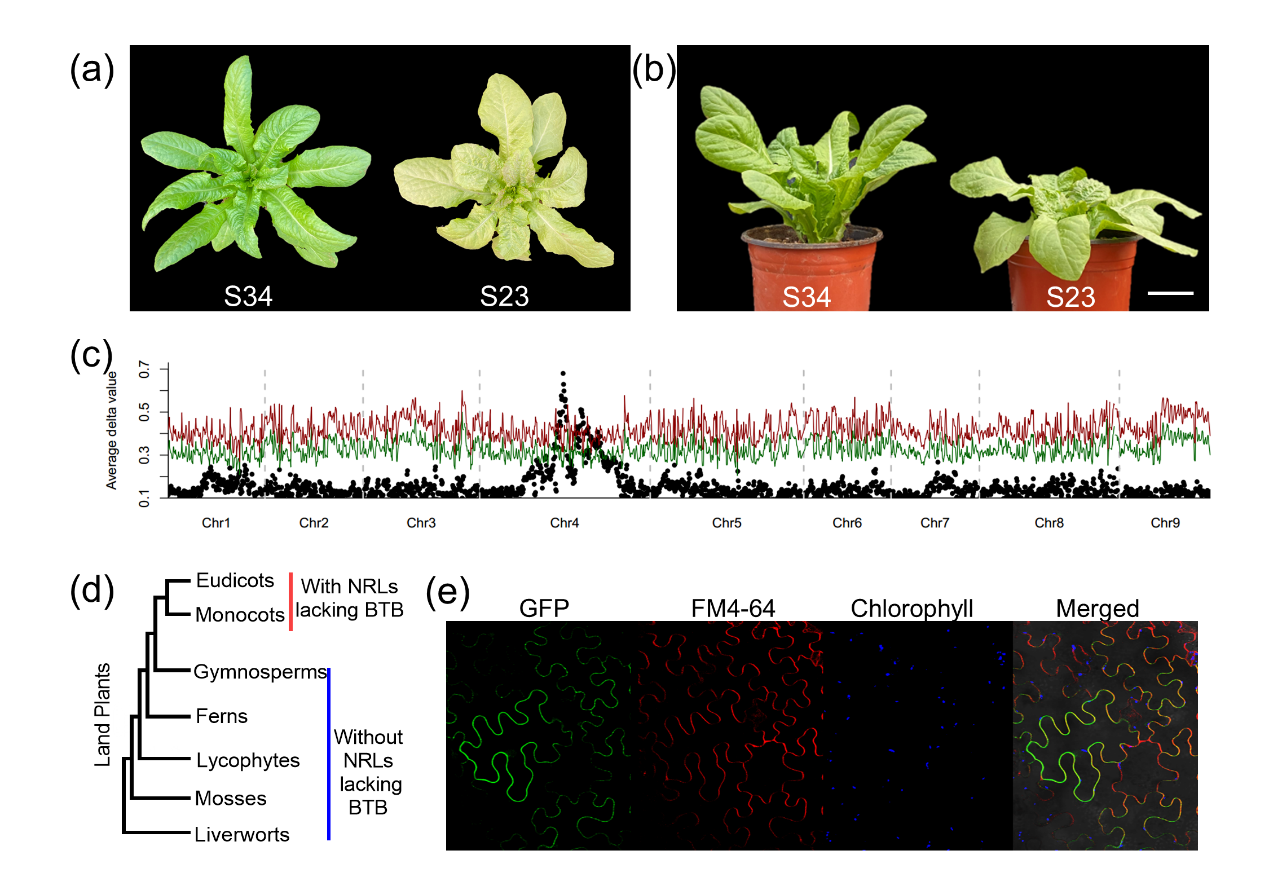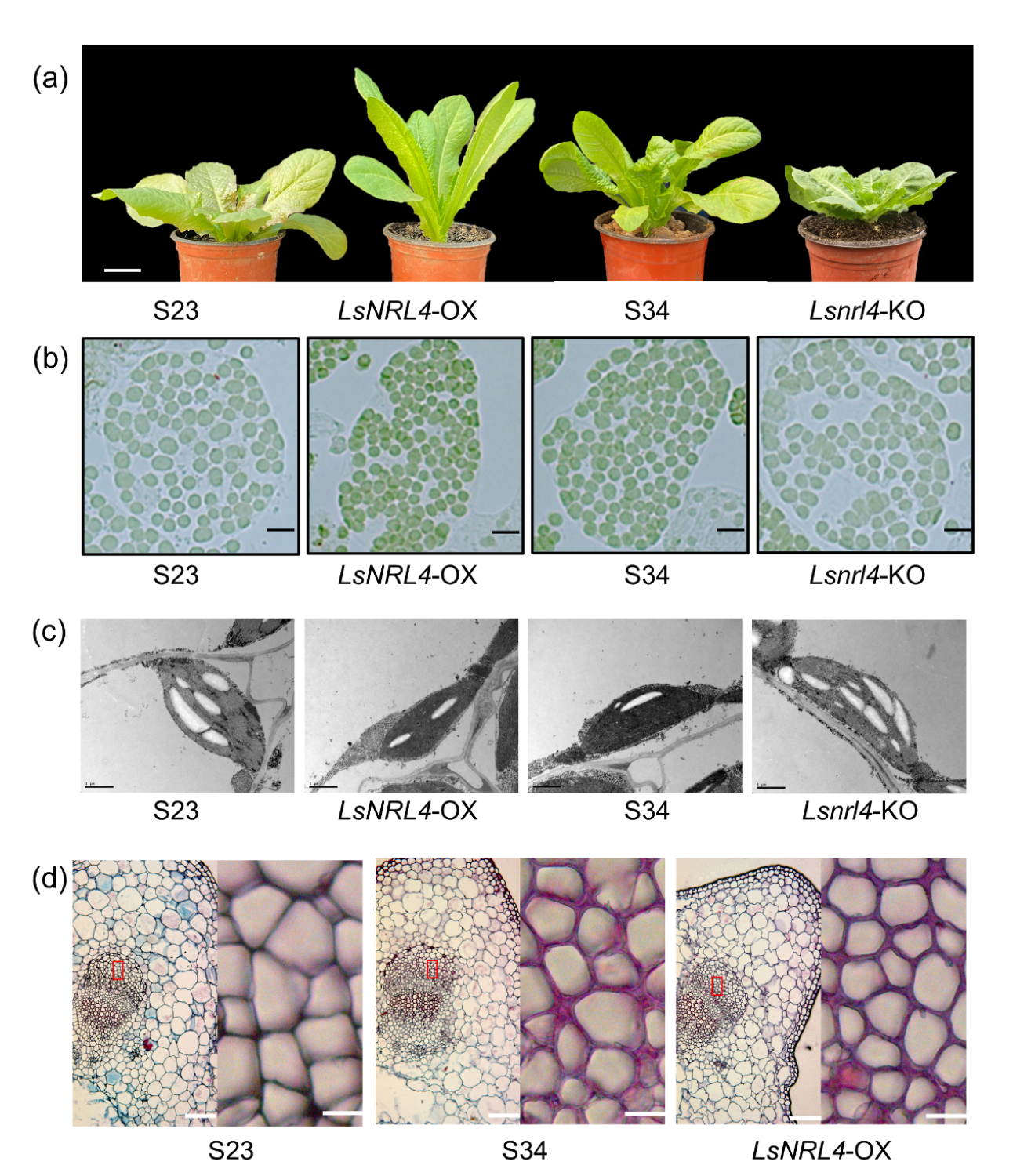南湖新闻网讯(通讯员 安光辉)近日,我校园艺植物生物学教育部重点实验室匡汉晖教授课题组在Plant Biotechnology Journal杂志上发表题为“LsNRL4 enhances photosynthesis and decreases leaf angles in lettuce”的研究论文。该论文阐明了一个新的NPH3/RPT2-Like (NRL) 家族的基因同时调控莴苣光合作用和叶夹角的遗传和分子机理。
莴苣是世界上最重要的蔬菜之一,莴苣当前也被认为是生产异源蛋白(如口服COVID-19疫苗)最好的植物载体之一。提高产量是莴苣育种和生产中亟待解决的问题。提高作物光合作用和减小叶夹角被认为是两种高效的增产方法,但莴苣光合作用以及双子叶植物叶夹角调控的遗传和分子机理仍不清楚。
作者通过“白”莴笋S23与深绿莴笋S34杂交获得遗传分离群体(图1a-b)。遗传分析显示叶绿色深浅和叶夹角大小由一个位点控制(图1c)。精细定位发现白莴笋中发生了大片段丢失,丢失的区域包含一个NRL家族成员,LsNRL4。它是NRL家族中的一个特殊成员,其编码的蛋白相比于其他NRL家族成员缺失了一个重要的BTB结构域。NRL4及其直系同源基因广泛分布在被子植物中(图1d),LsNRL4蛋白定位于细胞膜(图1e),但其功能仍不清楚。
该研究表明,在白莴笋中超量表达LsNRL4基因可以显著提高叶绿素累积和光合作用,同时减小叶夹角。使用CRISPR/cas9技术在LsNRL4功能正常的莴苣中敲除LsNRL4基因会导致叶绿素降低及光合效率下降,同时叶夹角增大(图2a)。
进一步研究表明,LsNRL4基因的功能丢失会导致叶绿体覆盖度和叶绿体个数显著下降(图2b),并引起叶绿体发育异常(图2c)。LsNRL4基因的功能丢失也会导致叶脉与茎的连接处的维管束厚壁细胞木质部发育异常,叶脉机械强度下降(图2d)。综上,LsNRL4基因通过调控叶绿体和维管束厚壁细胞的发育来参与莴苣的光合作用和株型建成(叶夹角)。本研究为了解NRL家族的功能提供了新思路,为提高莴苣种植密度和产量提供了新方法。
本研究由我校园艺植物生物学教育部重点实验室莴苣研究团队完成,匡汉晖教授为通讯作者,陈炯炯副教授为共同通讯作者,安光辉博士为第一作者。该研究得到了国家自然科学基金的资助。

图1. 调控莴苣光合作用和叶夹角的LsNRL4基因的图位克隆、基因分析和亚细胞定位。

图2. LsNRL4基因通过调控叶绿体和维管束厚壁细胞的发育来参与莴苣的光合作用和株型建成(叶夹角)
【英文摘要】
Lettuce (Lactuca sativa) is one of the most important vegetables worldwide, and an ideal plant for producing protein drugs. Both well-functioning chloroplasts that perform robust photosynthesis and small leaf angles that enable dense planting are essential for high yields. In this study, we used an F2 population derived from a cross between a lettuce cultivar with pale-green leaves and large leaf angles to a cultivar with dark-green leaves and small leaf angles to clone LsNRL4, which encodes an NPH3/RP T2-Like (NRL) prote in. Unlike othe rNRLp rote ins in lettuce,the LsNRL4 lacks the BTB domain. Knock out mutants engineered using CRISPR/Cas9 and transgenic lines over expressing LsNRL4 verified that LsNRL4 co ntrib utes to chloroplast development, photosynthesis, a nd leaf angle. The LsNRL4 gene was not present in t he parent with pale-green leaves and enlarged leaf angles. Loss of LsNRL4 results in the enlargement of chloroplasts, decreases in the amount of cellular space a lloca ted to chlorop lasts, and defects in secondary cell wall biosynthes is in lamina joints. Over expressing LsNRL4 significantly improved photosynthesis and decreased lea f angles. Indeed, the plant architecture of the over expressing lines is ideal for dense planting. In summary, we ident if ied a novel NRL gene that enhances photos ynthes is and influences plant architecture. Our study provides new approaches for the breeding of lettuce that can be grown in dense planting in the open field or in modern plant factories.LsNRL4 homologs may also be used in other crops to increase photosynthes is and improve plant architecture.
审核人:匡汉晖 陈炯炯
